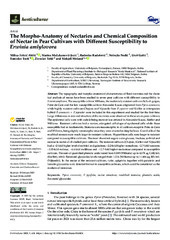Приказ основних података о документу
The Morpho-Anatomy of Nectaries and Chemical Composition of Nectar in Pear Cultivars with Different Susceptibility to Erwinia amlylovora
| dc.creator | Fotirić Akšić, Milica | |
| dc.creator | Mačukanović-Jocić, Marina | |
| dc.creator | Radošević, Radenko | |
| dc.creator | Nedić, Nebojša | |
| dc.creator | Gašić, Uroš | |
| dc.creator | Tosti, Tomislav | |
| dc.creator | Tešić, Živoslav | |
| dc.creator | Meland, Mekjell | |
| dc.date.accessioned | 2023-06-21T06:59:12Z | |
| dc.date.available | 2023-06-21T06:59:12Z | |
| dc.date.issued | 2023 | |
| dc.identifier.issn | 2311-7524 | |
| dc.identifier.uri | http://aspace.agrif.bg.ac.rs/handle/123456789/6338 | |
| dc.description.abstract | The topography and morpho-anatomical characteristics of floral nectaries and the chemical analysis of nectar have been studied in seven pear cultivars with different susceptibility to Erwinia amylovora. The susceptible cultivar Williams, the moderately resistant cultivars Bella di guigno, Poire de Cure and the low susceptible cultivar Alexander Lucas originated from Pyrus communis, while highly resistant cultivars Chojuro and Nijisseiki from P. pyraster and Kieffer as interspecies hybrid P. communis × P. pyraster were included in this experiment and studied for the first time. Large differences in size and structure of the nectaries were observed in these seven pear cultivars. The epidermal cells were with cuticle being more or less striated in Alexander Lucas, Kieffer and Williams. Resistant cultivars had a narrow, elongated cell shape of epidermal cells while those susceptible had an isodiametric. Stomata were mesomorphic in all cultivars except in Poire de Cure and Williams, being slightly xeromorphic since they were situated in deep hollows. Guard cells of the modified stomata were much larger in resistant cultivars. Hypanthium cells were larger in resistant compared to susceptible cultivars. The most abundant sugars were glucose, fructose, sorbitol and sucrose in nectar of all studied pear cultivars. The resistant cultivars (Chojuro, Kieffer and Nijisseiki) had a ~2-fold higher level of sorbitol and galactose, ~2.2-fold higher isomaltose, ~2.7-fold turanose, ~3.35-fold maltose, ~4.4-fold melibiose and ~12.7-fold higher melesitose compared to susceptible cultivars. The sum of quantified phenolic acids varied from 0.049 (Williams) up to 4.074 µg CAE/mL (Kieffer), while flavonoid glycosides levels ranged from 1.224 (Williams) up to 11.686 µg RE/mL (Nijisseiki). In the nectar of the resistant cultivars, rutin, apigetrin, together with patuletin and luteolin glycosides were detected but not in susceptible cultivars, which could be considered as the markers of resistance. © 2023 by the authors. | |
| dc.language | English | |
| dc.relation | info:eu-repo/grantAgreement/MESTD/inst-2020/200116/RS// | |
| dc.rights | openAccess | |
| dc.rights.uri | https://creativecommons.org/licenses/by/4.0/ | |
| dc.source | Horticulturae | |
| dc.source | Horticulturae | |
| dc.subject | flavonoid glycosides | |
| dc.subject | modified stomata | |
| dc.subject | nectar structure | |
| dc.subject | P. pyrifolia | |
| dc.subject | phenolic acids | |
| dc.subject | Pyrus communis | |
| dc.title | The Morpho-Anatomy of Nectaries and Chemical Composition of Nectar in Pear Cultivars with Different Susceptibility to Erwinia amlylovora | |
| dc.type | article | en |
| dc.rights.license | BY | |
| dc.citation.issue | 4 | |
| dc.citation.rank | M21~ | |
| dc.citation.volume | 9 | |
| dc.identifier.doi | 10.3390/horticulturae9040424 | |
| dc.identifier.fulltext | http://aspace.agrif.bg.ac.rs/bitstream/id/24549/The_Morpho-Anatomy_pub_2023.pdf | |
| dc.type.version | publishedVersion |


